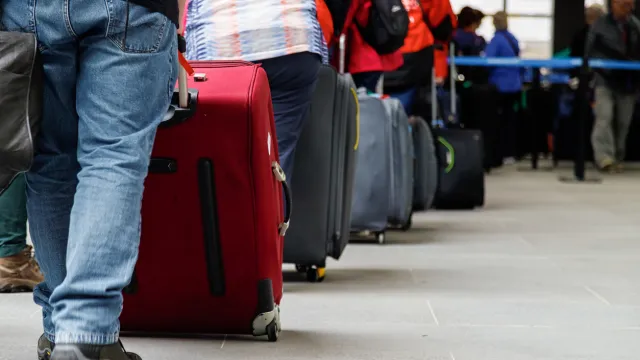New TSA Screening Will Get You Through Security in 12 Seconds—Here’s How

Going through a Transportation Security Administration (TSA) security checkpoint can be one of the most frustrating and unpredictable parts of flying. Sometimes, items in your carry-on could prompt a lengthy search process. And busy travel days can lead to agonizingly long lines and wait times just trying to reach your gate. Fortunately, new technology and programs are beginning to make the entire experience more efficient and effective. The latest is a new type of TSA screening that could get you through airport security checkpoints in as little as 12 seconds.
RELATED: Delta Flight Attendant Reveals Sneaky Way Airlines Trick You Into Missing Your Flight.
In a press release on Nov. 30, the U.S. Department of Homeland Security (DHS) announced the launch of a pilot program for self-service screening at Harry Reid International Airport in Las Vegas by late January. The program—which has been named Screening at Speed by officials—will allow passengers with TSA PreCheck to scan their own identification documents and use a unique screening portal without interacting with a TSA officer.
“Like self-ordering kiosks at fast food and sit-down restaurants, self-service screening allows passengers in the Trusted Traveler Program to complete the security screening process on their own,” John Fortune, PhD, the program’s manager, said in the release. “Travelers will use passenger and carry-on screening systems at individual consoles or screening lanes themselves, reducing the number of pat-downs and bag inspections TSOs [Transportation Security Officers] need to perform and freeing their time to be reallocated to the busier aspects of screening operations.”
The process will incorporate computed tomography (CT) bag scanners that the TSA has been rolling out in airports across the U.S. for the past few years. The upgraded technology allows travelers to keep liquids and electronics in their bags, The Washington Post reports. Passengers will then move on into an e-gate with automated entry and exit doors for a body scan.
“As you walk up, you don’t need to have a human say, ‘Come on in,'” Ha McNeill, a former TSA chief of staff who worked on research and development projects for the agency, told The Post. “The e-gate opens and the machine screens your body. If there is something you have forgotten to divest—let’s say you forgot your car keys in your pocket—then the back gate doesn’t open. It tells you to go back and take it out of your pocket and then come back in.”
Overall, officials say the efficiencies should allow the new program to process 300 travelers per hour per lane. That works out to just 12 seconds per person, Afar reports.
The Las Vegas rollout will be the second airport to see the prototypes put into action, joining a system installed at a TSA facility at Ronald Reagan National Airport in Washington, D.C., last March, Travel + Leisure reports. The agency told the publication that it could roll out the new technology to even more airports in the future if the pilot program proves successful, but added that it could take years for that to happen.
However, other experts warn that the technology’s high cost could slow the spread of the efficient new technology, per The Post. And even in places where it’s installed, it might take some getting used to.
“There’s going to be a massive learning curve with this, except it’s not just going to be a learning curve with the screener personnel,” McNeill told The Post. “It’s going to be a learning curve with all the passengers.”
RELATED: For more up-to-date information, sign up for our daily newsletter.